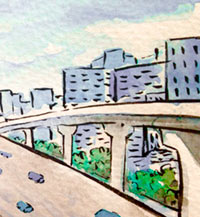COMMENT OF THE DAY: A BETTER IDEA FOR WHAT TO DO WITH THE SPACES UNDER FREEWAYS IN HOUSTON  “. . . This gave me an idea. That land under freeways isn’t good for retail or anything inhabited. But it could be a perfect place to dig down and create auxiliary stormwater detention facilities.
Yeah the water will be filthy, like your friends bikes usually are, but floodwater usually is. And as auxiliary detention they would only be used in extreme rainfall events (once or twice a year during so-called ‘hundred year’ storms).” [ZAW, commenting on Comment of the Day Second Runner-Up: Things To Think About Before You Start Planning Under-Freeway Developments] Illustration: Lulu
“. . . This gave me an idea. That land under freeways isn’t good for retail or anything inhabited. But it could be a perfect place to dig down and create auxiliary stormwater detention facilities.
Yeah the water will be filthy, like your friends bikes usually are, but floodwater usually is. And as auxiliary detention they would only be used in extreme rainfall events (once or twice a year during so-called ‘hundred year’ storms).” [ZAW, commenting on Comment of the Day Second Runner-Up: Things To Think About Before You Start Planning Under-Freeway Developments] Illustration: Lulu





I’ve been told that TXDOT is required to include stormwater detention as part of its planning, but only to the extent needed to mitigate its own drainage impact. It would be nice if TXDOT could coordinate with other agencies (HCFCD, Harris County, City of Houston, etc.), but the story I was told about the massive opportunity presented by the widening of the Katy Freeway was that TXDOT either couldn’t or wouldn’t coordinate, and no one was able to take advantage of the construction to improve upon the minimum requirements imposed on TXDOT. It’s bad enough when local developers have a NIMBY attitude about participating in obviously needed neighborhood drainage solutions (I’m looking at you, MetroNational), but when public agencies aren’t required to play nice with each other, it’s ridiculous. SBISD showed that it’s possible when they installed a huge amount of capacity beneath Frostwood Elementary when it was redeveloped.
Oh sure, we want our freeway supports sitting in a sodden lake for weeks – something they were not exactly designed to do. And if you do some volumetric calculations you will likely discover you could not sequester enough water to make a material impact.
Agreed, Al, and besides very few of the elevated freeways are in areas that flood
The thing that people don’t understand is that a few retention ponds aren’t going to stop the flooding. Was I the only person that saw the graphics of the ball of water over Houston that gave a to scale depiction of the amount of water that fell on Houston?
.
Those detention ponds would need to be REALLY deep to have any appreciable impact on the flooding created by a 100 year storm.
A better use of the space would be to create channels or tunnels for water to connect the bayous, eg: a channel/tunnel running beside/below hwy 6 to connect the dams/buffalo bayou, to other bayous downstream.. effects of flood waters would be spread out between bayous.. a system of expanding smaller creeks and connecting bayous with channels beside existing freeways would go a long way to spreading out water drainage from one area to multiple bayous..
@kvtt: A plan similar to that was discussed in the 1940s, and the only parts of it that were actualized were the Barker and Addicks Reservoirs. In general, though, bridging gaps between watersheds is looked at with tremendous scrutiny by civil engineers. Crossing the streams can create new technical challenges, environmental problems, and ethical dilemmas. It has even been suggested by no less an authority than Egon Spengler that doing so would result in, “all life as you know it stopping instantaneously and every molecule in your body exploding at the speed of light.” That would be bad, too, I guess.